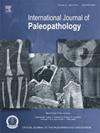佝偻病、吸收和革命:调查 18-19 世纪人口中儿童期维生素 D 缺乏与成年期骨质疏松症之间的关系
IF 1.5
3区 地球科学
Q3 PALEONTOLOGY
引用次数: 0
摘要
本研究采用健康与疾病的发展起源 (DOHaD) 方法,评估童年时期维生素 D 缺乏 (VDD) 对 18-19 世纪骸骨考古样本中成年后骨质疏松症风险的影响。方法 使用双能 X 射线吸收仪 (DXA) 扫描仪测量每个人的股骨颈和前四节腰椎骨的骨矿物质密度 (BMD),作为评估骨质疏松性骨折风险的替代方法。童年佝偻病对日后骨密度的影响可以通过体育锻炼和饮食等其他因素得到缓解。重要意义这是第一批采用 DOHaD 方法了解 18-19 世纪英格兰骨质疏松症风险的生物考古研究之一。它强调了骨质疏松症致病因素的复杂性,以及早年的VDD并不一定会导致成年后的骨质疏松症。评估儿童维生素 D 缺乏症的显微方法(如球间牙本质分析)并未应用。本文章由计算机程序翻译,如有差异,请以英文原文为准。
Rickets, resorption and revolution: An investigation into the relationship between vitamin D deficiency in childhood and osteoporosis in adulthood in an 18th-19th century population
Objective
This study employs a Developmental Origins of Health and Disease (DOHaD) approach to assess the effect of vitamin D deficiency (VDD) in childhood on the risk of osteoporosis in adulthood in an archaeological sample of skeletons dating from the 18th to 19th centuries.
Materials
Femora and lumbar vertebrae of 65 adults aged 18+ years (26 diagnosed with residual rickets and 39 without) from an 18th-19th century Quaker burial ground at Coach Lane, North Shields, England.
Methods
Bone mineral density (BMD) was measured for the femoral neck and first four lumbar vertebrae of each individual using a dual energy X-ray absorptiometry (DXA) scanner as a proxy for assessing osteoporotic fracture risk.
Results
3-way ANOVA revealed no statistically significant differences in BMD between individuals with and without residual rickets across age and sex.
Conclusions
A combination of lifestyle and environmental factors likely influenced the BMD of people buried at Coach Lane across the life course. The impact of childhood VDD on BMD later in life can be mitigated through other factors such as physical activity and diet.
Significance
This is one of the first bioarchaeological studies to take a DOHaD approach to understand osteoporosis risk in 18th-19th century England. It highlights the complexity of aetiological factors for osteoporosis and that VDD in early life does not necessarily predispose a person to osteoporosis in adulthood.
Limitations
BMD is not the only indicator of osteoporosis. Microscopic methods for the assessment of childhood vitamin D deficiency, such as inter-globular dentine analysis, were not applied.
求助全文
通过发布文献求助,成功后即可免费获取论文全文。
去求助
来源期刊

International Journal of Paleopathology
PALEONTOLOGY-PATHOLOGY
CiteScore
2.90
自引率
25.00%
发文量
43
期刊介绍:
Paleopathology is the study and application of methods and techniques for investigating diseases and related conditions from skeletal and soft tissue remains. The International Journal of Paleopathology (IJPP) will publish original and significant articles on human and animal (including hominids) disease, based upon the study of physical remains, including osseous, dental, and preserved soft tissues at a range of methodological levels, from direct observation to molecular, chemical, histological and radiographic analysis. Discussion of ways in which these methods can be applied to the reconstruction of health, disease and life histories in the past is central to the discipline, so the journal would also encourage papers covering interpretive and theoretical issues, and those that place the study of disease at the centre of a bioarchaeological or biocultural approach. Papers dealing with historical evidence relating to disease in the past (rather than history of medicine) will also be published. The journal will also accept significant studies that applied previously developed techniques to new materials, setting the research in the context of current debates on past human and animal health.
 求助内容:
求助内容: 应助结果提醒方式:
应助结果提醒方式:


